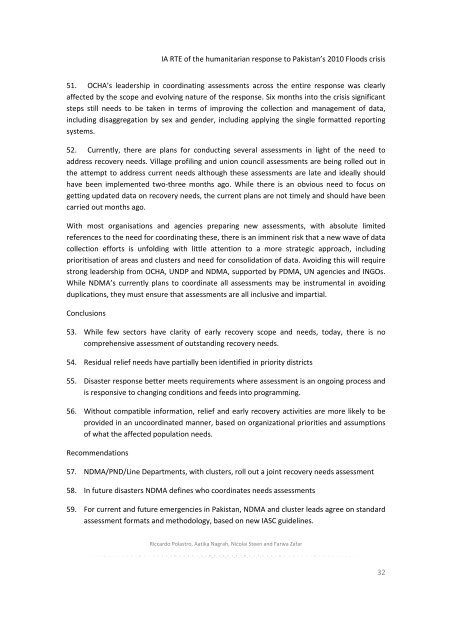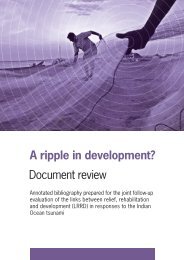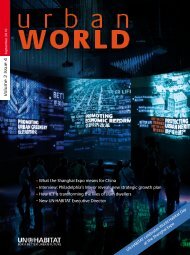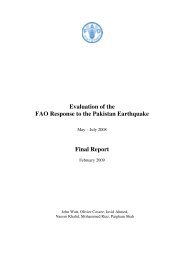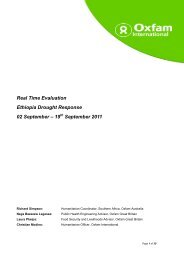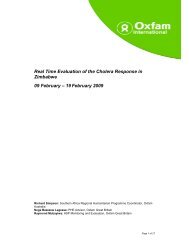Inter-Agency Real Time Evaluation of the Humanitarian ... - alnap
Inter-Agency Real Time Evaluation of the Humanitarian ... - alnap
Inter-Agency Real Time Evaluation of the Humanitarian ... - alnap
You also want an ePaper? Increase the reach of your titles
YUMPU automatically turns print PDFs into web optimized ePapers that Google loves.
IA RTE <strong>of</strong> <strong>the</strong> humanitarian response to Pakistan’s 2010 Floods crisis<br />
51. OCHA’s leadership in coordinating assessments across <strong>the</strong> entire response was clearly<br />
affected by <strong>the</strong> scope and evolving nature <strong>of</strong> <strong>the</strong> response. Six months into <strong>the</strong> crisis significant<br />
steps still needs to be taken in terms <strong>of</strong> improving <strong>the</strong> collection and management <strong>of</strong> data,<br />
including disaggregation by sex and gender, including applying <strong>the</strong> single formatted reporting<br />
systems.<br />
52. Currently, <strong>the</strong>re are plans for conducting several assessments in light <strong>of</strong> <strong>the</strong> need to<br />
address recovery needs. Village pr<strong>of</strong>iling and union council assessments are being rolled out in<br />
<strong>the</strong> attempt to address current needs although <strong>the</strong>se assessments are late and ideally should<br />
have been implemented two‐three months ago. While <strong>the</strong>re is an obvious need to focus on<br />
getting updated data on recovery needs, <strong>the</strong> current plans are not timely and should have been<br />
carried out months ago.<br />
With most organisations and agencies preparing new assessments, with absolute limited<br />
references to <strong>the</strong> need for coordinating <strong>the</strong>se, <strong>the</strong>re is an imminent risk that a new wave <strong>of</strong> data<br />
collection efforts is unfolding with little attention to a more strategic approach, including<br />
prioritisation <strong>of</strong> areas and clusters and need for consolidation <strong>of</strong> data. Avoiding this will require<br />
strong leadership from OCHA, UNDP and NDMA, supported by PDMA, UN agencies and INGOs.<br />
While NDMA’s currently plans to coordinate all assessments may be instrumental in avoiding<br />
duplications, <strong>the</strong>y must ensure that assessments are all inclusive and impartial.<br />
Conclusions<br />
53. While few sectors have clarity <strong>of</strong> early recovery scope and needs, today, <strong>the</strong>re is no<br />
comprehensive assessment <strong>of</strong> outstanding recovery needs.<br />
54. Residual relief needs have partially been identified in priority districts<br />
55. Disaster response better meets requirements where assessment is an ongoing process and<br />
is responsive to changing conditions and feeds into programming.<br />
56. Without compatible information, relief and early recovery activities are more likely to be<br />
provided in an uncoordinated manner, based on organizational priorities and assumptions<br />
<strong>of</strong> what <strong>the</strong> affected population needs.<br />
Recommendations<br />
57. NDMA/PND/Line Departments, with clusters, roll out a joint recovery needs assessment<br />
58. In future disasters NDMA defines who coordinates needs assessments<br />
59. For current and future emergencies in Pakistan, NDMA and cluster leads agree on standard<br />
assessment formats and methodology, based on new IASC guidelines.<br />
Riccardo Polastro, Aatika Nagrah, Nicolai Steen and Farwa Zafar<br />
32


